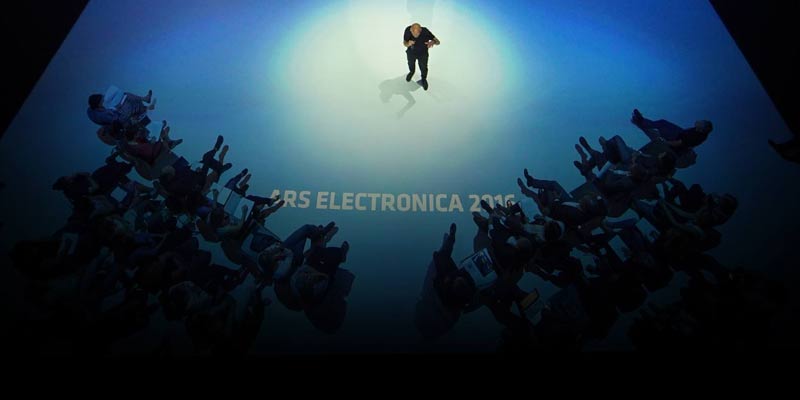European Digital Art and Science Network reprises its open call for
A Residency at the ESO and Ars Electronica
(Linz, October 16, 2015) For the second consecutive year, Ars Electronica and the European Southern Observatory (ESO) are offering an artist the extraordinary opportunity to spend a residency at the ESO in Chile and then at the Ars Electronica Futurelab in Linz. Prospective participants can submit an application to ars.electronica.art/artandscience/en/ in the form of a video elaborating on the concrete ideas and projects they aim to develop and the inspiration they hope to derive. The deadline is November 29, 2015. An international jury made up of representatives of all European Digital Art and Science Network member institutions will select the residency recipient. The resulting work of art will be showcased at the next Ars Electronica Festival September 8-12, 2016 in Linz.
Residencies at the Nexus of Art and Science
The European Digital Art and Science Network aims to link up scientific aspects and ideas with approaches used in digital art. Fostering interdisciplinary work and intercultural exchange as well as gaining access to new target audiences are among its declared goals. There is also strong emphasis on art’s role as a catalyst in processes of social renewal. By creating images and narratives dealing with the potential risks and rewards inherent in technological and scientific development, artists exert an important influence on how our society comes to terms with these innovations.
Residency at the ESO
The first part of the residency is a stay of several weeks duration at the ESO. Throughout his/her stay, the artist will be accompanied by a scientific mentor. Then, the scene shifts to Linz, where the Ars Electronica Futurelab’s staff will provide support as the artist proceeds to develop the artistic concept and to bring the project to fruition.
“The European Southern Observatory is one of the world’s foremost institutions in the field of terrestrial-based astronomy. Whereas scientists regard these facilities ‘only’ as elaborate instruments for research in astrophysics, they’re quite a bit more than that from the points of view of visitors active a wide variety of disciplines! They’re a manifestation of humankind’s technological progress, real-world demonstrations of the logistical solutions that are called for to operate such facilities in very remote areas, textbook examples of international cooperation for peaceful purposes and, simply, sources of inspiration for people such as the artists who have already been permitted to partake of this experience,” said Fernando Comerón, ESO Representative in Chile.
Residency at the Ars Electronica Futurelab
The second part of the residency is a one-month stay at the Ars Electronica Futurelab, where staff experts and mentors will support the artist in the creation and development of new works that were inspired by the residency at the ESO.
The Ars Electronica Futurelab focuses on promising developments at the nexus of art, technology and society. The staff’s work is based on a transdisciplinary approach to R&D; thus, the skills and qualifications of the men and women who work here are correspondingly wide-ranging. Artists and researchers from throughout the world who collaborate with the Ars Electronica Futurelab and are recipients of residencies at the atelier/lab are essential to this mode of carrying out assignments.
Public Presentation
The results of the residency will premiere at the 2016 Ars Electronica Festival, and then be exhibited as part of a modular traveling exhibition to run at the seven cultural institutions (Center for the promotion of science, RS – DIG gallery, SK – Zaragoza City of Knowledge Foundation, ES – Kapelica Gallery / Kersnikova, SI – GV Art, UK – Laboral, ES – Science Gallery, IE) that comprise the European Digital Art and Science Network.
Previously Produced Projects
The first ESO Residency in conjunction with the European Digital Art and Science Network was conducted in spring/summer 2015. Chilean artist Maria Ignacia Edwards was selected from among 140 applicants from 40 countries. She completed her residency in May/June at the ESO in Chile and then spent her term at the Ars Electronica Futurelab in August. “Encuentros,” the work of art that was inspired by her residency, made its debut at the 2015 Ars Electronica Festival. It will be part of the “Elements of Art and Science” exhibition that opens on October 28, 2015 at the Ars Electronica Center.
This project has been funded with support from the European Commission. This publication (communication) reflects the views only of the author, and the Commission cannot be held responsible for any use which may be made of the information contained therein.
http://www.flickr.com/photos/arselectronica/15456083004/
Logo Art & Science – European Digital Art and Science Network / Printversion
http://www.flickr.com/photos/arselectronica/15464497664/
ESO Observatory La Silla / Y. Beletsky (LCO), ESO / Printversion / Album
http://www.flickr.com/photos/arselectronica/20494586438/
Maria Ignacia Edwards, Gewinnerin der ersten Residency / Magdalena Leitner / Printversion / Album

